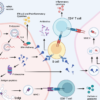Researchers from Nagoya University Institute of Transformative Biomolecules (WPI-ITbM) in Japan and their colleagues have identified and derivatized a chemical compound that effectively regulates the density of stomata in model plants. Stomata are crucial for water regulation.
As the environment grows increasingly unpredictable, managing water consumption for crops during droughts through chemical methods will become increasingly important. The results of their study were published in Nature Communications.
Manipulating protein interactions using chemical compounds is revolutionizing biology because it allows researchers to influence complex processes in the target organism. In plant biology, these approaches hold promise to create more durable or nutritious crops.
The university team, led by Ayami Nakagawa and Keiko Torii, synthesized Stomidazolone, a chemical compound that inhibits stomatal differentiation in plants.
Stomata are microscopic pores located on the surfaces of plant leaves. They are essential for photosynthesis and transpiration. Photosynthesis converts light energy into glucose and oxygen, while transpiration involves water vapor loss from leaves, aiding nutrient transport and temperature control.
“Our research group (Torii group) has screened numerous small molecules to identify new factors that can probe and manipulate stomatal development. We found Stomidazolone, which was ideal as it does not affect plant growth but reduces stomata and can be applied through a simple treatment,” Nakagawa explained.
“Using this to reduce stomatal density in principle causes plants to lose less water through transpiration, helping them conserve moisture in dry environments without hindering growth.”
Stomatal development is regulated by specific proteins referred to as basic-helix-loop-helix proteins. In plants, the protein MUTE pairs with another called SCREAM to form stomata. Using comprehensive genetic testing and biophysical analysis, the research team discovered that Stomidazolone functions through binding to a unique protein domain, called ACT-like domain of MUTE, which stops it from connecting with SCREAM.
Based on these findings, the group also created MUTE proteins with enhanced resilience against Stomidazolone, while maintaining their function.
“When these modified MUTE proteins were tested in plants, they continued developing stomata, even in the presence of Stomidazolone,” Nakagawa said. “This demonstrated that we could use precise chemical interventions to selectively control plant development.”
This research represents a significant advancement in employing chemical compounds to target specific proteins, aiming to regulate crucial biological functions.
Dr. Torii explains her vision, “By expanding the chemical tools available for manipulating plant development, we deepen our understanding of how plants grow and unlock new possibilities for agricultural innovations using stoma control. I hope our research will help engineer crops that can thrive in challenging and drought environments.”
More information:
Chemical inhibition of stomatal differentiation by perturbation of the master-regulatory bHLH heterodimer via an ACT-Like domain, Nature Communications (2024). DOI: 10.1038/s41467-024-53214-4
Provided by
Institute of Transformative Bio-Molecules (ITbM), Nagoya University
Citation:
New chemical treatment reduces number of plant pores that regulate water loss (2024, October 23)



